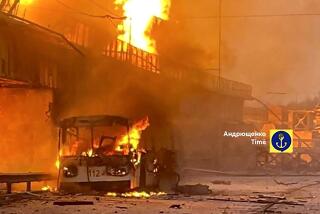Soviet Economy a Casualty in Plant Fire : U.S. Sees Serious Toll to Agriculture, Industry; Curbs Expected
WASHINGTON — Beyond its impact on life and health, the Chernobyl nuclear plant disaster will take a serious toll on the Soviet economy, Administration officials and other specialists said Friday.
Although they declined to estimates costs without more information, the damage and lost output will almost surely add up to many billions of dollars. Electrical power generation will be retarded for months or more, experts said, and agricultural production will suffer in an area within 30 to 50 miles of the plant.
Soviet leader Mikhail S. Gorbachev’s “economic plans for 1986 will have to be readjusted very, very considerably,” said Dmitri Simes, a senior associate of the Carnegie Endowment for International Peace.
Simes noted that the nuclear meltdown comes on the heels of the collapse of world oil prices and falling Soviet oil production. “I am not predicting an economic disaster,” he told the National Press Club, but he forecast “a lot of belt tightening.”
Administration officials took a more cautious line. “There will undoubtedly be economic problems,” one said, “but there are so many uncertainties that we are most hesitant to try to quantify the effect.”
A State Department official added: “We should be careful not to overestimate the economic effects, too, because the Soviet Union is one big country. Even if all the farmland around the plant is put off limits, it’s a small percentage of the total.
“But they have clearly lost some major nuclear electricity generating capacity, and at a time when they were planning a major expansion of nuclear plants. Gorbachev will have to rethink his nuclear power program at least.”
The gutted 1,000-megawatt reactor represents the greatest single direct loss. A replacement reactor of that size in the United States would cost about $2 billion, according the Atomic Industrial Forum, although economists estimated that the cost to the Soviets would be about half that total.
In addition, the Soviets face huge cleanup costs. In the United States, the cleanup cost for the damaged Three Mile Island reactor in Pennsylvania after its 1979 accident was about $1 billion.
And then there is the lost power output not only from the destroyed reactor but possibly from the 13 other identical graphite-moderated reactors in the Soviet Union. The three sister reactors at the Chernobyl plant are already shut down and will probably remain so for months or more because of radiation damage.
The four units at Chernobyl produced well over 1% of all Soviet electricity, according to the Atomic Industrial Forum, and this loss could cost the Soviet economy many billions of dollars if they remain down for a year.
As a rule of thumb, each percentage-point rise in electric power production is correlated with a 1% increase in a nation’s gross national product. But the reverse is not necessarily true, said Prof. Frank Holtzman of Tufts University, because substitute sources of energy may be found.
“A drop in electricity output should have some (downward) effect on the GNP,” he added, but he declined to estimate the amount.
May Cut Exports to East Bloc
The Soviets may be able to draw electricity to the Chernobyl area from other parts of the country through their huge power grids. The Soviets might also reduce the amount of electricity they export to Eastern Europe, although Administration officials said that such action would entail political costs for the Soviet Union and threaten Eastern Europe with reduced economic output.
There are reports that the 10 other reactors of the same type outside Chernobyl have also been shut down, at least temporarily. The Soviets might have to make costly design modifications at these plants.
The reactors have operated safely for many years, so the modifications may be minimal before they are brought back on line, one U.S. official said. But the accident investigation commission appointed by the Kremlin appears to be dominated by scientists rather than the “nuclear industry establishment,” he said, and it could produce a highly critical report that would set back the Soviet atomic power network for years.
The economic impact of the Chernobyl disaster on Soviet agriculture is more difficult to estimate because of the absence of information about radiation levels and distribution. Wind shifts and rain may still affect the outcome.
Earl Merritt, vice president of Earth Satellite Corp., which monitors agricultural output globally with the use of Landsat satellite photographs, estimated that the greatest fallout occurred in an area of about 2,700 square miles within 30 to 50 miles of the plant.
Sugar Beet Crop Loss
He forecast that about half of the region’s crops, mostly sugar beets, will be lost. He put no monetary value on it.
If a similar accident occurred here, Merritt said, top soil would be plowed under or mechanically removed. What the Soviets will do is unknown, he said, but he expects no major residue of the fallout into next year.
Farther away, several authorities said, the fallout will be more diffuse and, except for strontium-90 in milk, not dangerous. “It’s relatively short-lived contamination,” said Agriculture Department meteorologist Norton Strommen. “If they switch to uncontaminated feed, this will clear up . . . in a week or 10 days.”
Strommen said radiation leakage from the plant has stopped and the great bulk of Soviet farmland will escape damage. Most of the nation’s crops have not been exposed, he said.
Although the significant radiation levels will extend out to 100 miles, according to Dennis Avery, a State Department analyst, it is not clear that the crops beyond 50 miles will be discarded or even that farmers will refuse to work on the land. “I doubt the Soviets will react on an emotional level to radioactivity like the Swedes do,” he said.
Sweden and Denmark, citing the fallout danger, have banned many food imports from the Soviet Union and Eastern Europe. This could have a significant impact on the hard-currency earnings of the East Bloc nations, particularly if the boycott spreads to major West European nations.
More to Read
Sign up for Essential California
The most important California stories and recommendations in your inbox every morning.
You may occasionally receive promotional content from the Los Angeles Times.










